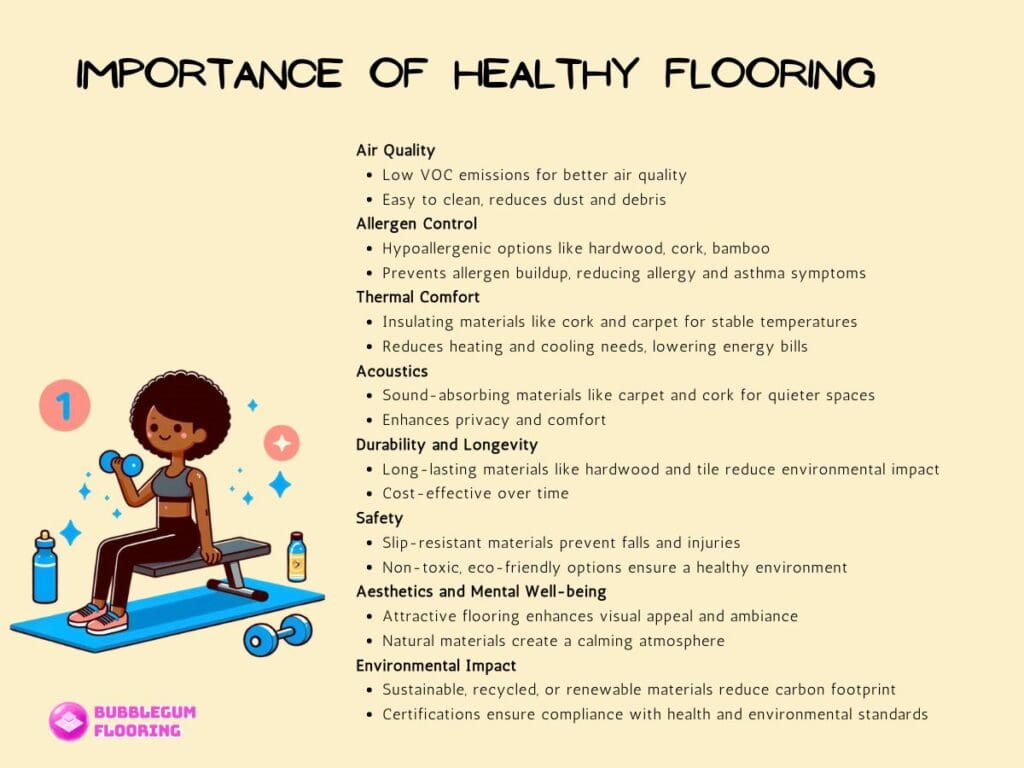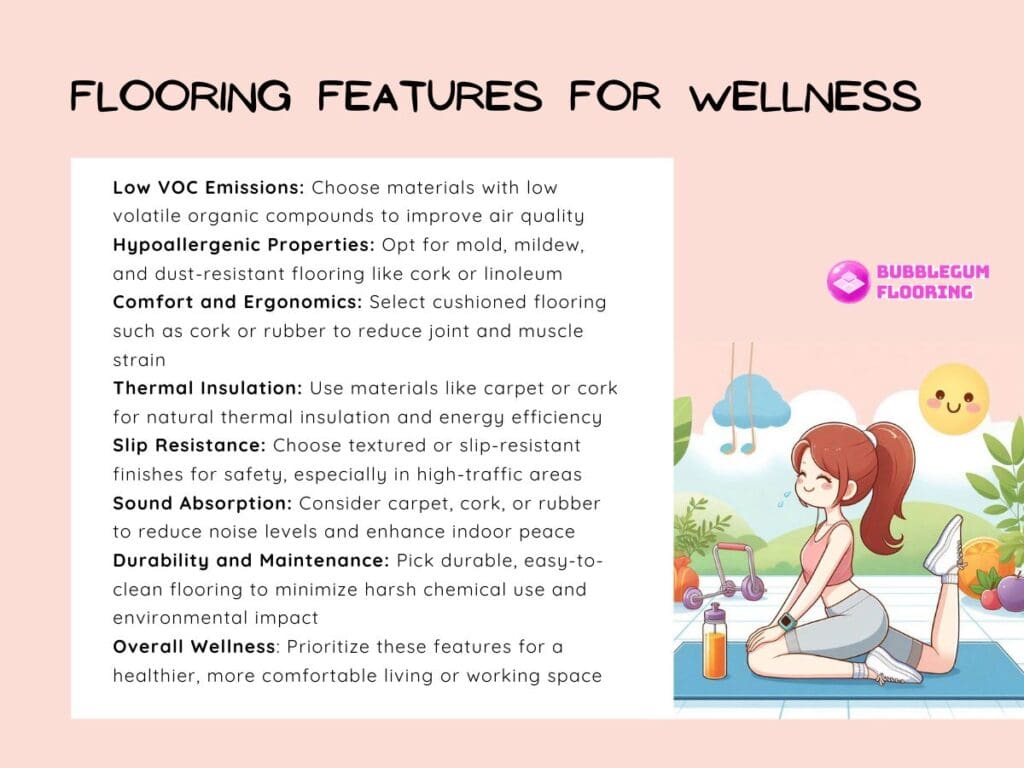In today’s pursuit of healthier and more sustainable living spaces, the choice of flooring plays a crucial role. This article flooring for wellness exploring a range of sustainable and safe flooring options designed to enhance indoor environments while minimizing environmental impact. From rapidly renewable bamboo and naturally resilient cork to eco-friendly linoleum and recycled materials, each option offers unique advantages such as improved indoor air quality, durability, and safety.
Additionally, considerations include the benefits of natural stone’s timeless appeal and the comfort and resilience of rubber flooring. Discover how these choices align with certifications like GREENGUARD and FloorScore, ensuring your flooring meets stringent environmental and health standards. By selecting these sustainable flooring solutions, you can create spaces that not only promote well-being but also contribute to a greener future for generations to come.
The Connection Between Indoor Environments and Health
The concept of “healthy buildings” is gaining traction in design and construction. Research shows that factors like indoor air quality (IAQ), acoustics, and thermal comfort can significantly impact occupant health, productivity, and overall well-being. Poor IAQ, for instance, can lead to respiratory problems, allergies, and even contribute to Sick Building Syndrome (SBS). Traditional flooring materials can sometimes be detrimental to IAQ by trapping allergens, emitting harmful Volatile Organic Compounds (VOCs), or harboring mold and mildew growth.
Importance of Healthy Flooring
Healthy flooring is a crucial aspect of creating a comfortable and safe indoor environment. Its importance is evident through its impact on air quality, allergen control, thermal comfort, acoustics, and overall well-being.

1. Air Quality
Healthy flooring materials emit fewer volatile organic compounds (VOCs), which are harmful chemicals that can contribute to indoor air pollution and cause respiratory issues, headaches, and other health problems. Additionally, flooring that is easy to clean and does not trap dust and debris can contribute to better air circulation and overall air quality within a space.
2. Allergen Control
Certain flooring types, such as hardwood, cork, and bamboo, do not harbor dust mites, pet dander, or other allergens, reducing the risk of allergic reactions and asthma symptoms. Flooring that can be easily cleaned helps prevent the buildup of allergens and dust, maintaining a healthier environment, especially for individuals with allergies or respiratory conditions.
3. Thermal Comfort
Flooring materials like cork and carpet provide insulation, helping to maintain a stable indoor temperature. This contributes to thermal comfort, making spaces feel warmer in the winter and cooler in the summer. Well-insulated flooring can also reduce the need for heating and cooling, leading to lower energy consumption and utility bills.
4. Acoustics
Flooring materials such as carpet and cork can absorb sound, reducing noise levels within a space. This creates a quieter and more peaceful indoor environment, which is especially important in multi-family housing, offices, and educational settings. Proper flooring can minimize the transmission of sound between floors and rooms, enhancing privacy and comfort.
5. Durability and Longevity
Durable flooring materials, like hardwood and tile, have a longer lifespan, reducing the frequency of replacement and the associated environmental impact. This contributes to sustainability by minimizing waste. Additionally, long-lasting flooring requires less frequent replacement, which can be cost-effective in the long run.
6. Safety
Certain flooring materials are designed to be slip-resistant, reducing the risk of falls and injuries, particularly in areas prone to moisture, such as bathrooms and kitchens. Using non-toxic and eco-friendly flooring materials ensures that the indoor environment is free from harmful chemicals that could pose health risks.
7. Aesthetics and Mental Well-being
Flooring plays a significant role in the overall aesthetics of a space. Attractive and well-maintained flooring can enhance the visual appeal, contributing to a pleasant and welcoming atmosphere. The look and feel of flooring can influence mood and comfort levels, with natural materials like wood and bamboo creating a warm and calming ambiance.
8. Environmental Impact
Selecting sustainable flooring options, such as those made from recycled or renewable materials, supports environmental conservation and reduces the carbon footprint. Choosing flooring with certifications like GREENGUARD, FloorScore, and FSC ensures compliance with environmental and health standards, promoting a healthier and more sustainable living environment.
By considering factors such as air quality, allergen control, thermal comfort, acoustics, durability, safety, aesthetics, and environmental impact, you can make informed choices that contribute to the well-being of all occupants. Investing in healthy flooring not only enhances the quality of life but also supports sustainable and eco-friendly practices.
Sustainable and Safe Flooring Options
There are several sustainable and safe flooring options available that prioritize environmental impact, indoor air quality, and overall durability. Here are some popular choices:
- Bamboo Flooring – Bamboo is a fast-growing renewable resource that can be harvested without harming the plant. It’s durable and can mimic the look of hardwood flooring.
- Cork Flooring – Cork is harvested from the bark of cork oak trees, which regenerate after harvesting. It’s resilient, provides thermal and acoustic insulation, and is naturally resistant to mold and mildew.
- Linoleum Flooring – Made from natural materials like linseed oil, cork dust, and wood flour, linoleum is biodegradable and doesn’t emit harmful chemicals. It’s durable and comes in a variety of colors and styles.
- Recycled/Reclaimed Hardwood – Using reclaimed wood from old buildings or responsibly sourced recycled wood reduces environmental impact and gives a unique, rustic look.
- Rubber Flooring – Made from recycled rubber tires, rubber flooring is durable, slip-resistant, and absorbs impact. It’s ideal for high-traffic areas and provides good insulation.
- Recycled Glass Tile – Made from recycled glass bottles and other waste glass, these tiles come in various colors and are durable and easy to maintain.
- Natural Stone – Options like slate, granite, or marble are natural, durable, and long-lasting. They can be sourced locally to reduce the impact of transportation.
- Wool Carpet – Wool is a renewable resource that is naturally resistant to stains and flames. It’s biodegradable and improves indoor air quality by absorbing pollutants.
When choosing sustainable flooring, look for certifications such as FSC (Forest Stewardship Council) for wood products or FloorScore for low VOC emissions to ensure your flooring choice is both environmentally friendly and safe for indoor air quality.
Flooring Features for Wellness
Flooring can significantly impact wellness by contributing to indoor air quality, comfort, and safety. Here are key features to consider for flooring that promotes wellness:

- Low VOC Emissions – Opt for flooring materials with low volatile organic compound (VOC) emissions to improve indoor air quality and reduce respiratory irritants.
- Hypoallergenic Properties – Choose flooring that is resistant to mold, mildew, and dust accumulation, such as cork or linoleum, to create a healthier indoor environment, especially for allergy sufferers.
- Comfort and Ergonomics – Select flooring that provides cushioning and support underfoot, like cork or rubber, to reduce strain on joints and muscles, enhancing overall comfort.
- Thermal Insulation – Flooring materials such as carpet or cork provide natural thermal insulation, helping to maintain a comfortable room temperature and reduce energy costs.
- Slip Resistance – Opt for flooring with textured surfaces or finishes that offer slip resistance, promoting safety and preventing accidents, especially in high-traffic areas or homes with elderly individuals or young children.
- Sound Absorption – Consider flooring materials like carpet, cork, or rubber that absorb sound and reduce noise levels, creating a quieter and more peaceful indoor environment.
- Durability and Maintenance – Choose durable flooring options that are easy to maintain and clean, minimizing the use of harsh chemicals and reducing environmental impact.
By prioritizing these features in your flooring choice, you can create a healthier and more comfortable living or working environment that contributes positively to overall wellness.
Installation and Maintenance Tips
Here are some installation and maintenance tips for various types of flooring:
- Follow Manufacturer Guidelines – Always adhere to the manufacturer’s specific installation instructions for your chosen flooring type to ensure proper installation and avoid voiding warranties.
- Prepare and Acclimate – Ensure the subfloor is clean, dry, and level before installation. Additionally, flooring materials such as wood and bamboo should be allowed to acclimate to the room’s humidity and temperature for optimal performance.
- Use Proper Tools – Utilize recommended tools and equipment for installation to ensure precision and durability. This includes saws, adhesive applicators, and spacers as necessary.
- Consider Professional Installation – Complex flooring types like natural stone or intricate patterns may benefit from professional installation to achieve the best results.
- Establish a Cleaning Routine – Regularly sweep, vacuum, or mop using suitable cleaners designed for your flooring type to maintain cleanliness and prevent buildup.
- Protect Against Damage – Minimize exposure to moisture, use furniture pads to prevent scratches, and place area rugs or mats in high-traffic areas to preserve your flooring’s longevity.
- Inspect and Maintain – Periodically inspect for wear, damage, or potential issues. Addressing these early can prevent costly repairs and extend the lifespan of your flooring.
By following these combined tips, you can ensure the successful installation and ongoing maintenance of your flooring, promoting both durability and aesthetic appeal in your space.
Summary
This article delves into a variety of sustainable and safe flooring choices aimed at improving indoor environments while advocating for environmental responsibility. It starts by highlighting the eco-friendly benefits of bamboo and cork flooring, emphasizing their sustainability and natural resistance to pests and mold. Linoleum and recycled materials are also explored for their minimal environmental impact and positive effects on indoor air quality.
Additionally, the article examines the durability and aesthetic appeal of natural stone, as well as the safety and comfort advantages of rubber flooring. Certifications like GREENGUARD and FloorScore are underscored as essential for ensuring that flooring meets stringent environmental and health criteria. By considering these options, readers can make informed decisions to create healthier, more sustainable living spaces that prioritize both well-being and environmental stewardship.


